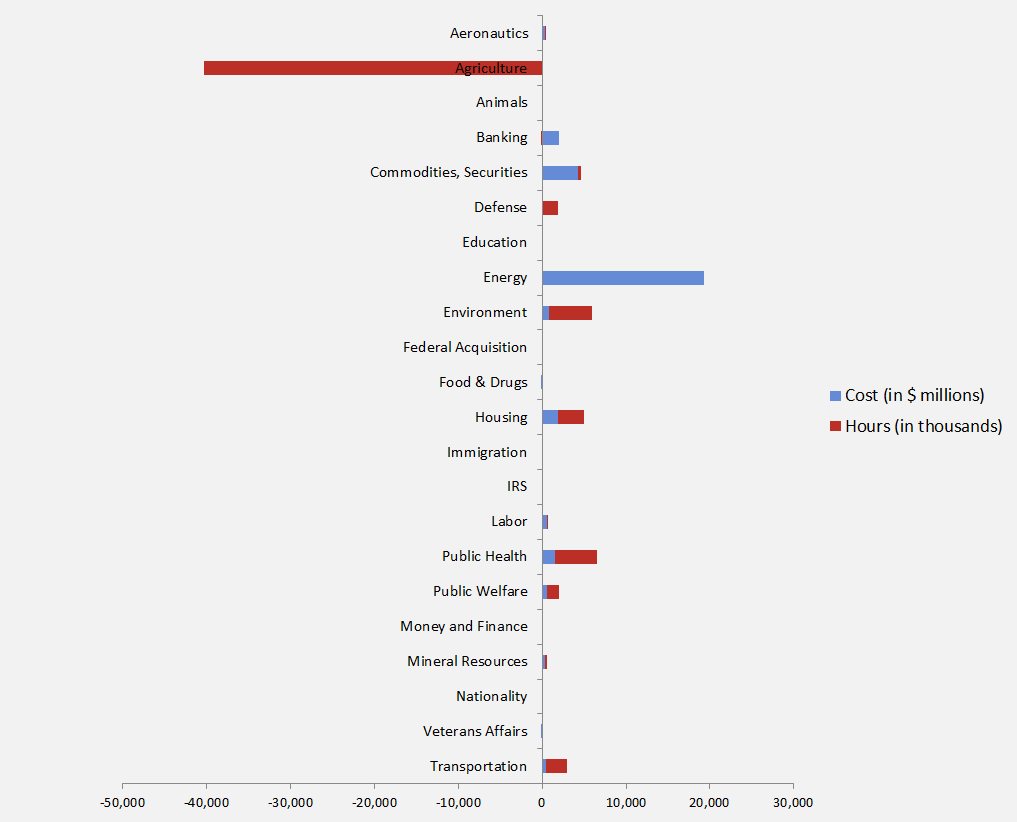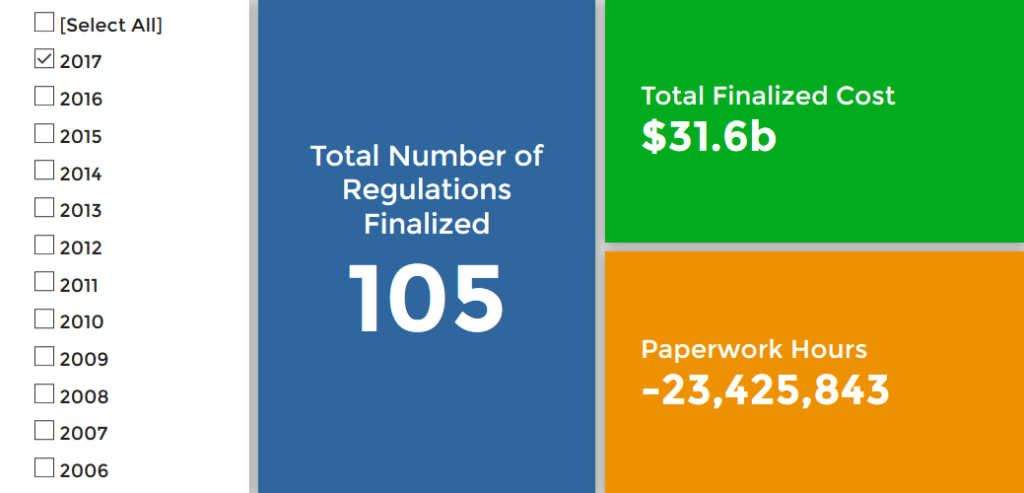Week in Regulation
June 19, 2017
A Surprising $96 Million Week
Courtesy of a final Federal Reserve rule for checking and a legacy regulation from the Obama Administration, total costs accelerated by $96 million this week. Annual costs were $95 million and there were no listed benefits; paperwork grew by more than 402,000 hours. The per capita regulatory burden for 2017 is $449.
Regulatory Toplines
- New Proposed Rules: 41
- New Final Rules: 65
- 2017 Total Pages of Regulation: 27,770
- 2017 Final Rules: $31.6 Billion
- 2017 Proposed Rules: $114.2 Billion
The American Action Forum (AAF) has catalogued regulations according to their codification in the Code of Federal Regulations (CFR). The CFR is organized into 50 titles, with each title corresponding to an industry or part of government. This snapshot of final rules (a change from earlier versions) will help to determine which sectors of the economy receive the highest number of regulatory actions.
The big surprise this week was a final EPA rule on effluent emission standards for the dental industry. The rule was proposed in 2014 and then the Obama Administration approved the final rule on December 8, 2016, the so-called “midnight” period for regulation. However, it was never formally printed in the Federal Register, until this week. The rule imposes $60 million in annual costs, 402,000 hours of paperwork, and is a “significant” rulemaking, likely making it eligible under the president’s one-in, two-out executive order on regulation. However, there is no discussion of the executive order or what future regulatory offsets the administration plans. It’s possible that: 1) it’s not considered “new” because it was from the previous administration or 2) because it was drafted by the previous administration, there was never a discussion of President Trump’s executive order and EPA nevertheless intends to identify regulatory offsets. Regardless, the administration will likely answer these questions when it releases its Unified Agenda of federal rules.
The Federal Reserve finalized a rule to implement the Check 21 Act, adopting new warranties for checks collected and returned electronically. The rule will cost each small institution roughly $3,000 annually, or $31 million total for the 10,185 affected institutions.
This week, OIRA finished review of a proposed rule relating to occupational exposure to beryllium, which was originally finalized by the Obama Administration. OIRA also received five rulemakings, including a measure to revise the “Coal Combustion Residuals” rule, which originally imposed $23 billion in costs.
Tracking Regulatory Modernization
The Department of Labor proposed the formal rescission of the “Persuader Rule.” The cost savings are only expected at $1.2 million. This figure mirrors the earlier estimate from the 2016 final rule.
On regulatory budget implementation, below are the agencies that have accrued annual savings or new costs (assuming the EPA rule counts toward the budget) under the president’s one-in, two-out budget:
- Defense: -$400 million
- Interior: -$360 million
- Education: -$100 million
- Labor: -$78 million
- Veterans Affairs: -$1.9 million
- HHS: -$0.02 million
- EPA: $60 million
Many of these figures are the result of CRA resolutions of disapproval. Given their historic regulatory output, AAF can predict that Defense, Interior, and Education will likely meet the goal of $0 in net regulatory costs by the end of this fiscal year.
Affordable Care Act
Since passage, based on total lifetime costs of the regulations, the Affordable Care Act has imposed costs of $53 billion in final state and private-sector burdens and 176.9 million annual paperwork hours.
Dodd-Frank
Click here to view the total estimated revised costs from Dodd-Frank; since passage, the legislation has produced more than 74.8 million final paperwork burden hours and imposed $38.5 billion in direct compliance costs.
Total Burdens
Since January 1, the federal government has published $146.3 billion in compliance costs ($31.6 billion in final rules) and has cut 18.4 million paperwork burden hours (due to 23.4 million in reductions from final rules). Click below for the latest Reg Rodeo findings.












